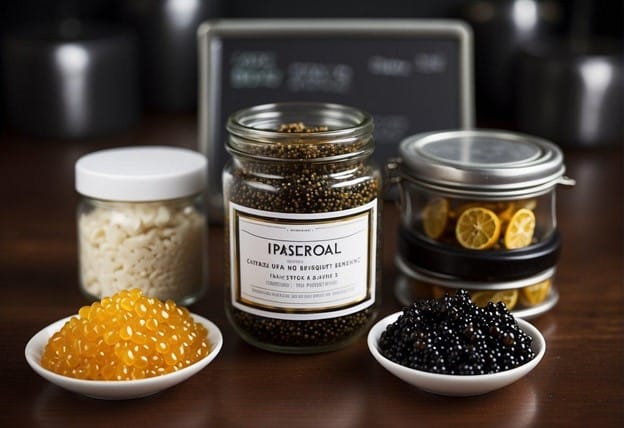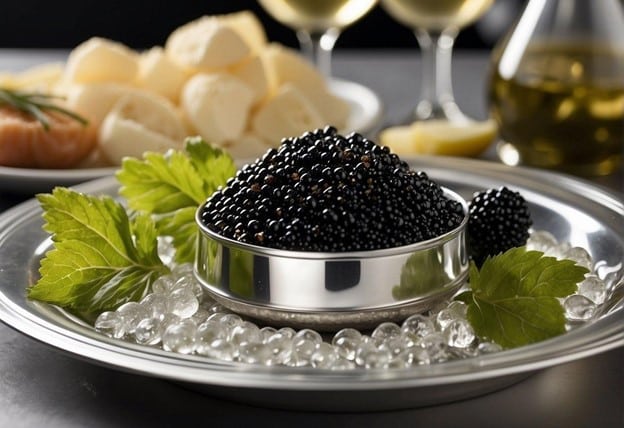Table of Contents
Caviar, traditionally regarded as a luxurious delicacy, is more than just a symbol of gastronomic opulence. Sterling Caviar, a prized item, consisting of sturgeon fish eggs, brings a host of nutritional benefits that contribute to a healthy diet. Rich in vitamins and minerals, caviar notably contains vitamin B12, important for maintaining healthy nerve cells and aiding in the production of DNA. In addition, its high levels of omega-3 fatty acids, DHA and EPA are beneficial for cardiovascular health and cognitive function.
The nutritional profile of caviar is enhanced by its content of iron which plays a crucial role in transporting oxygen in the blood, as well as selenium, a mineral that supports the immune system and thyroid function. Moreover, its vitamins and other essential nutrients like zinc and calcium, contribute to a well-rounded, nutrient-dense food choice. While indulging in caviar, one also receives the added advantage of its low-calorie nature, which makes it a guilt-free addition to various diets.
Caviar’s concentrated source of nutrients signifies its potential in improving overall health. The presence of antioxidants like vitamin C and E can aid in skin rejuvenation and may reduce signs of aging. It’s a food that, despite its indulgent connotations, aligns well with a healthy lifestyle when consumed in moderation. As research continues to uncover the depths of caviar’s health benefits, it stands as a compelling inclusion for those aiming to enrich their diet with nutritious foods.
Nutritional Profile and Health Benefits
Caviar is recognized for its unique and luxurious nutritional composition which includes high levels of vitamins, minerals, and omega-3 fatty acids crucial for overall health.
Vitamins and Minerals
Caviar boasts a variety of essential vitamins and minerals. It is particularly high in Vitamin B12, which is necessary for maintaining healthy nerve cells and forming red blood cells. Moreover, it provides a good source of selenium, which plays a key role in the immune system and thyroid function. Iron is another notable mineral found in caviar essential for blood health.
- Vitamin A: Important for vision and the immune system.
- Vitamin D: Beneficial for bone health and immune function.
- Vitamin E: Acts as an antioxidant protecting cells from damage.
- Calcium: Crucial for bone health and muscle function.
- Zinc: Vital for immune function and skin health.
Fatty Acids and Proteins
Caviar contains high levels of omega-3 fatty acids, including EPA and DHA, which are associated with heart and brain health. As a source of high-quality protein, caviar includes all essential amino acids necessary for muscle repair and growth.
Heart and Brain Health
The omega-3 fatty acids in caviar are influential in cardiovascular health as they can lower blood pressure, reduce blood cholesterol levels, and decrease the risk of heart disease. These fatty acids also support brain function, potentially improving cognitive function and mood.
Skin and Immune System
The antioxidants found in caviar, such as Vitamin E, along with zinc, contribute to skin and immune health. Caviar can protect against wrinkles while supporting the body’s defense against infections and diseases.
Weight Management and Metabolism
Although caviar is rich in nutrients, it is relatively low in calories. It also contains a protein that may influence weight management by impacting the hormone adiponectin, which plays a role in breaking down fats and regulating metabolism.
Bone and Muscle Health
Caviar’s high content of vitamins and minerals like calcium and vitamin D supports bone strength and integrity. The proteins and amino acids in caviar assist in muscle repair, crucial after physical activity for muscle recovery and strength.
Culinary Uses and Serving Suggestions

Caviar is celebrated for its versatility in the culinary world, complementing both traditional dishes with its delicate texture and enhancing modern cuisine with its unique flavor profile.
Traditional and Modern Pairings
One can serve caviar atop blinis with a dollop of crème fraîche or alongside crackers as a simple yet elegant appetizer. The addition of caviar to salads provides a luxurious twist to everyday dining. It also pairs beautifully with a variety of garnishes, such as chopped onion, chives, or a squeeze of lemon to balance its richness. As a versatile ingredient, chefs often include caviar in pasta dishes to elevate the complexity of flavors.
- Traditional Pairings:
- Blinis with crème fraîche
- Chopped onions and chives
- Crackers with soft cheese
- Modern Pairings:
- Caviar-topped salads
- Pasta with caviar sauce
- Garnishing soups or sushi
Appropriate Serving Sizes
Caviar is traditionally served in small quantities; a serving size can range from half a teaspoon to a full tablespoon. Consumption in moderation is key due to its rich flavor and high salt content. A standard guideline to follow is 10 to 30 grams per person when included as part of a meal.
| Serving Context | Suggested Serving Size |
|---|---|
| As a garnish | 5 grams |
| Stand-alone | 10 to 30 grams |
| Within recipes | 5 to 10 grams |
Incorporating caviar into one’s culinary repertoire should respect the ingredient’s opulence by adhering to these serving sizes. Whether enhancing a sophisticated entrée or enjoying caviar in its pure form, the key to its indulgence lies in its moderation.
Potential Risks and Considerations

While caviar has numerous health benefits, consumers should be aware of its potential risks and considerations related to allergies, mercury content, and dietary implications.
Allergies and Sensitivities
Caviar, like other seafood products, can trigger allergic reactions in some individuals. Symptoms of a seafood allergy may range from mild to severe and can include hives, swelling, difficulty breathing, or anaphylaxis. Therefore, individuals with known sensitivities should avoid caviar and consult healthcare professionals before trying new seafood products.
Pregnancy and Mercury Concerns
For pregnant women, the mercury content in fish is a significant concern due to its potential effects on fetal development. Although caviar is generally lower in mercury compared to larger fish, it’s imperative to analyze the source of caviar for contaminants. Pregnant women are advised to limit their consumption of caviar and follow dietary guidelines to minimize mercury exposure.
Dietary Recommendations
Caviar is high in cholesterol and sodium, which could have implications for individuals with specific health conditions such as hypertension or heart diseases. Moderation is key, and those with concerns should consider caviar as an occasional delicacy rather than a regular part of their diet. Despite its nutritious profile, potential side effects related to its cholesterol and sodium content should not be overlooked, and incorporating it within dietary guidelines for cholesterol and sodium intake is recommended.


